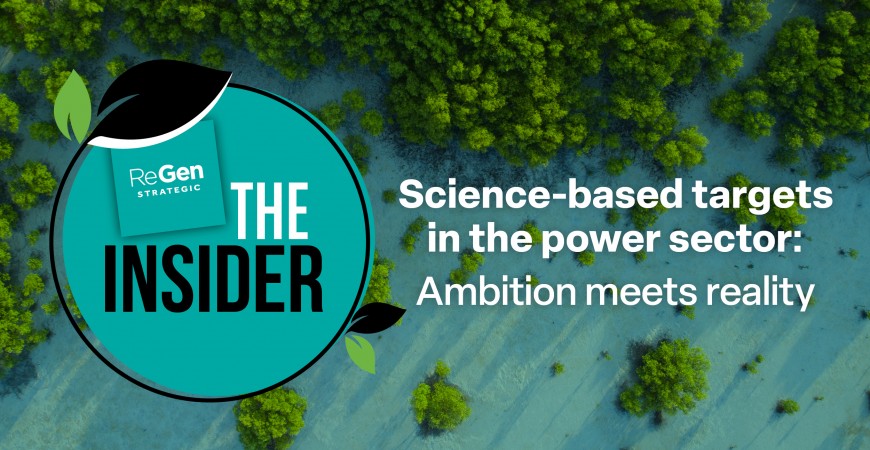The draft Power Sector Net-Zero Standard from the Science Based Targets initiative (SBTi) represents an important and necessary step in aligning the global power industry with the 1.5°C climate target. It sends a strong signal to energy companies, investors, and regulators alike that only ambitious, science-aligned decarbonisation strategies will be considered credible in the years ahead.
This is a welcome development. At ReGen Strategic, we support the principle that the power sector must be a leader in emissions reduction, as it accounts for over 40% of energy-related CO₂ annually.
However, in our work with energy clients across Western Australia and beyond, we recognise the tension between technical ambition and implementation reality. For many operators - including those already deploying best available technology (BAT) - meeting the proposed requirements of the draft SBTi standard will not be straightforward.
And that tension deserves more open discussion.
The Shift from Efficiency to Absolute Emissions Reductions
For some time, power companies have focused on improving emissions intensity by generating more electricity with fewer emissions per megawatt-hour. The draft SBTi standard, however, signals a paradigm shift. It goes beyond efficiency and demands absolute emissions reductions, including full phase-out of unabated fossil fuel generation over a defined timeframe.
While this shift is scientifically justified, it creates a very real dilemma for operators of modern gas-fired power stations, especially those already using state-of-the-art turbines, combined-cycle technologies, and robust emissions control systems.
These facilities often provide essential dispatchable power to stabilise the grid, particularly in Western Australia where renewable integration remains constrained by limited transmission capacity and planning bottlenecks. Many were built or upgraded relatively recently, in line with prevailing government policies and investor expectations at the time.
Now, under the new standard, these same assets may face:
- Accelerated obsolescence or stranded asset risk, despite high efficiency and ongoing system reliability
- Regulatory uncertainty around what constitutes "acceptable" transitional infrastructure in a science-based framework
- Limited access to credible abatement pathways such as CCS or green hydrogen, particularly in regions where these technologies remain commercially or technically unviable in the medium term
This is not about resisting climate action. It’s about recognising that science-based pathways need to be implemented in a world with real constraints i.e. technical, financial, geographic, and political.
Challenges Beyond the Gas-Fired Fleet
The implications of the draft SBTi standard also extend well beyond gas-fired generation. Power companies across the value chain from generation and storage to transmission and retail will also likely face a range of new challenges, including:
- Scope 3 emissions disclosures - which may involve upstream fuel emissions or downstream electricity usage over which companies have limited control
- The need for detailed, auditable transition plans - which will require significant internal resourcing, capability uplift, and data governance reforms
- Long-term target setting (2040–2050) - which is inherently complex in a sector undergoing rapid technological and regulatory change
- Investor and stakeholder scrutiny - where companies must strike a careful balance between climate ambition and commercial viability
For companies already making genuine efforts to reduce emissions and contribute to energy system transformation, these requirements may feel like a moving goalpost.
Welcoming the Standard, Acknowledging the Gap
To be clear, the SBTi’s work is crucial. A standardised, science-aligned benchmark for the power sector helps drive accountability and comparability both of which are essential in the transition to a net-zero economy. It helps guard against greenwashing, raises ambition, and sets a clear signal to markets.
But the draft also reveals that a gap needs to be bridged between the vision of a fully decarbonised power system and the current operational realities of many providers, especially in regions like Western Australia.
The question now becomes, how do we support companies that are part of the transition but not yet able to meet every future requirement?
Do we risk penalising those who are genuinely progressing but not fast enough?
Or can the voluntary framework provide clearer pathways for transitional assets, with transparency and credibility, but without writing them off prematurely?
At ReGen, we work with clients across the power sector who are committed to reducing emissions but face real-world constraints. Our role is to help them translate ambition into practical strategy, while also advocating for policy settings that enable a just, realistic, and science-based transition.
We believe it’s possible and necessary to maintain a high standard of climate ambition while also engaging honestly with the complexities of implementation.
As the SBTi aims to finalise its Power Sector Net-Zero Standard by late 2025 as part of its voluntary framework, we encourage broader industry discussion. Let’s create space for open, constructive dialogue that not only supports the end goal of net-zero but also ensures we get there in a way that is fair, feasible, and grounded in real-world energy systems.
 ReGen Strategic
ReGen Strategic